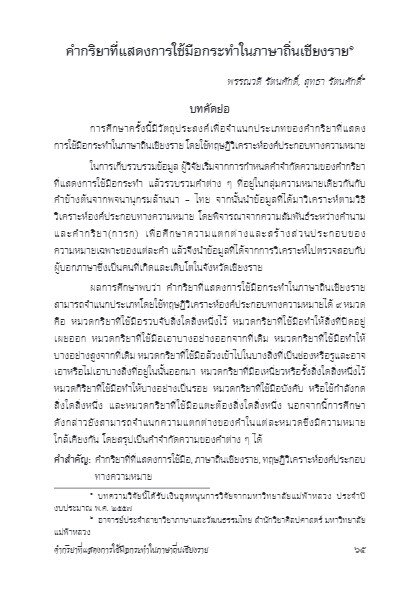พรรณวดี รัตนศักดิ์ และ สุทธา รัตนศักดิ์
บทคัดย่อ
การศึกษาครั้งนี้มีวัตถุประสงค์เพื่อจำแนกประเภทของคำกริยาที่แสดงการใช้มือกระทำในภาษาถิ่นเชียงราย โดยใช้ทฤษฎีวิเคราะห์องค์ประกอบทางความหมาย
ในการเก็บรวบรวมข้อมูล ผู้วิจัยเริ่มจากการกำหนดคำจำกัดความของคำกริยาที่แสดงการใช้มือกระทำ แล้วรวบรวมคำต่าง ๆ ที่อยู่ในกลุ่มความหมายเดียวกันกับคำข้างต้นจากพจนานุกรมล้านนา–ไทย จากนั้นนำข้อมูลที่ได้มาวิเคราะห์ตามวิธีวิเคราะห์องค์ประกอบทางความหมาย โดยพิจารณาจากความสัมพันธ์ระหว่างคำนามและคำกริยา(การก) เพื่อศึกษาความแตกต่างและสร้างส่วนประกอบของความหมายเฉพาะของแต่ละคำ แล้วจึงนำข้อมูลที่ได้จากการวิเคราะห์ไปตรวจสอบกับผู้บอกภาษาซึ่งเป็นคนที่เกิดและเติบโตในจังหวัดเชียงราย
ผลการศึกษาพบว่า คำกริยาที่แสดงการใช้มือกระทำในภาษาถิ่นเชียงรายสามารถจำแนกประเภทโดยใช้ทฤษฎีวิเคราะห์องค์ประกอบทางความหมายได้ 9 หมวด คือ หมวดกริยาที่ใช้มือรวบจับสิ่งใดสิ่งหนึ่งไว้ หมวดกริยาที่ใช้มือทำให้สิ่งที่ปิดอยู่เผยออก หมวดกริยาที่ใช้มือเอาบางอย่างออกจากที่เดิม หมวดกริยาที่ใช้มือทำให้บางอย่างสูงจากที่เดิม หมวดกริยาที่ใช้มือล้วงเข้าไปในบางสิ่งที่เป็นช่องหรือรูและอาจเอาหรือไม่เอาบางสิ่งที่อยู่ในนั้นออกมา หมวดกริยาที่มือเหนี่ยวหรือรั้งสิ่งใดสิ่งหนึ่งไว้ หมวดกิริยาที่ใช้มือทำให้บางอย่างเป็นรอย หมวดกริยาที่ใช้มือบังคับ หรือใช้กำลังกดสิ่งใดสิ่งหนึ่ง และหมวดกริยาที่ใช้มือแตะต้องสิ่งใดสิ่งหนึ่ง นอกจากนี้การศึกษาดังกล่าวยังสามารถจำแนกความแตกต่างของคำในแต่ละหมวดซึ่งมีความหมายใกล้เคียงกัน โดยสรุปเป็นคำจำกัดความของคำต่าง ๆ ได้
คำสำคัญ : คำกริยาที่ที่แสดงการใช้มือ, ภาษาถิ่นเชียงราย, ทฤษฎีวิเคราะห์องค์ประกอบทางความหมาย
(ตีพิมพ์ใน วารสารไทยศึกษา ปีที่ 12 ฉบับที่ 2 (กรกฎาคม – ธันวาคม 2559) หน้า 65-94)
A Semantics Study of Hand-Related Verbs in Chaingrai Dialect of Thai
Panwadee Rattanasak and Suttha Rattanasak
Abstract
This study aims at classifying types of hands-related verbs spoken in Chiang Rai dialects by using componential analysis.
For the data collection procedure, the researcher started with defining hands-related verbs and grouping them in accordance with the Lanna-Thai dictionary. Then, the data was analyzed using componential analysis by taking the interrelationship between nouns and verbs into consideration to study the differences and components of each word. The data was checked by language informants who were originally born and raised in Chiang Rai.
The study showed that hands-related verbs can be grouped into nine categories: hands-related verbs indicating how to hold something; hands-related verbs indicating how to uncover something; hands-related verbs indicating how to move something; hands-related verbs showing how to raise something; hands-related verbs showing how to grasp something in a hole or take something out, which may or may not take something out of the hole; hands-related verbs showing how to make a scratch; hands-related verbs showing how to control or press something; and hands-related verbs showing how to touch something. In addition, this study also showed the differences of words in each category which denotes their closely-related meanings.
Keywords : hands-related verbs , Chiang Rai dialects , componential analysis
(Published in Journal of Thai Studies Volume 12 Number 2 (July – December 2016) Page 65-94)
บทความ / Full Text : Download
